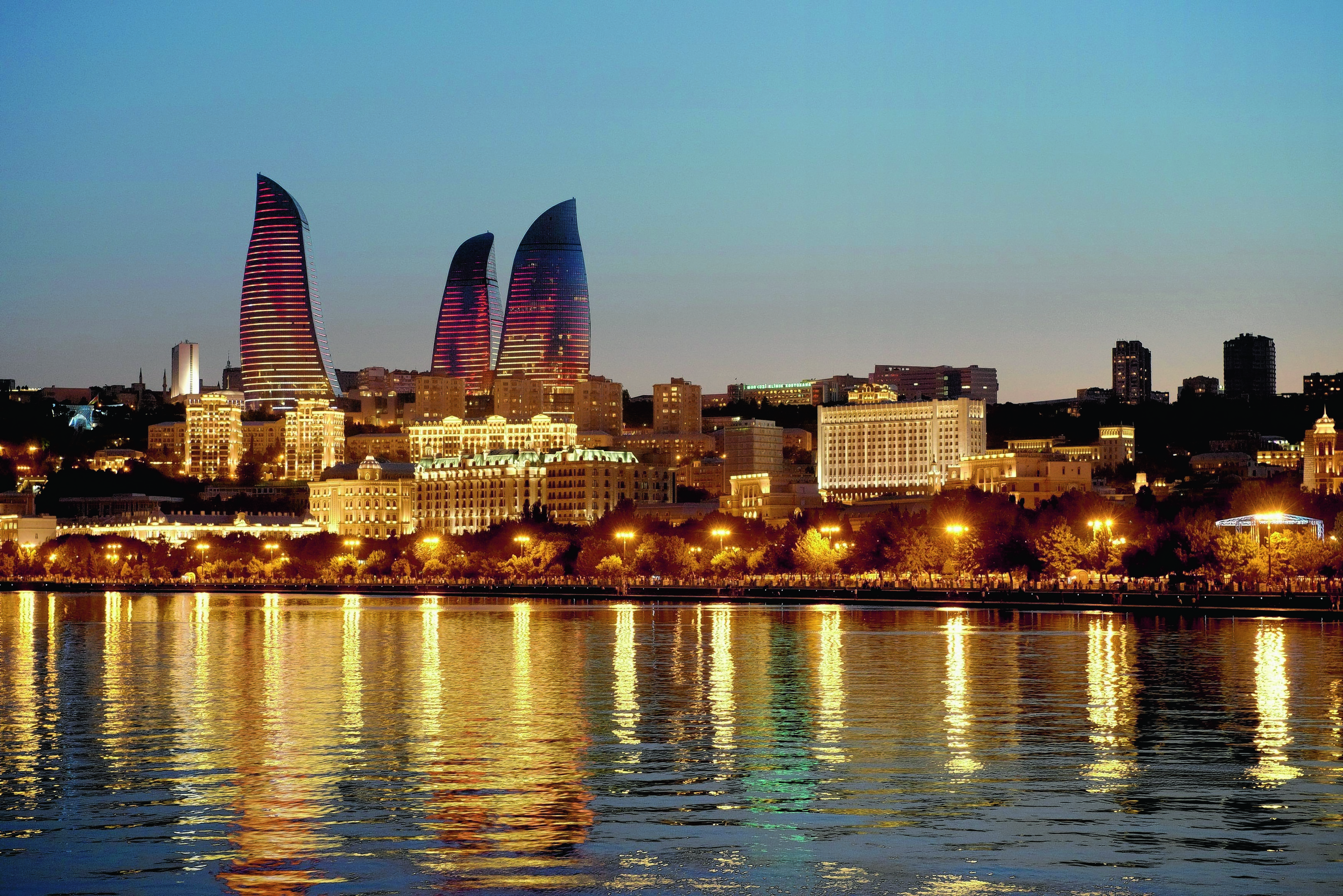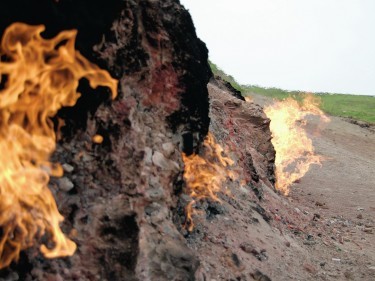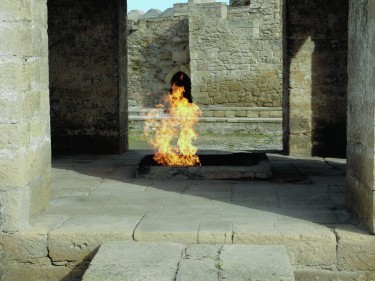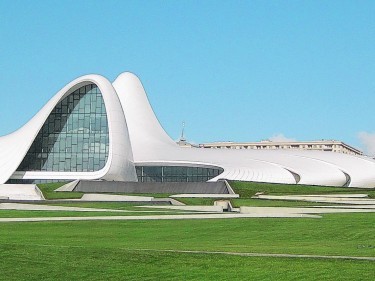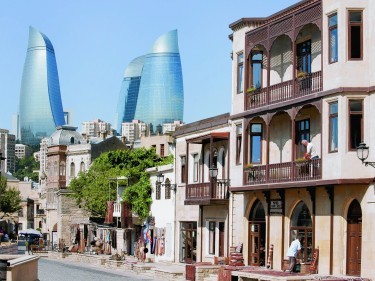Better known for its oil and gas industries, Baku is hardly the first choice for a city break. But with new hotel openings and flight routes, the destination is opening up to leisure tourism
I cautiously approach a fire which has been burning for at least 50 years on the side of a mountain outside Baku, the capital city of Azerbaijan.
Tendrils of flame, several metres high, leap menacingly from the base of an outwardly unremarkable rocky cliff face.
Underneath the red sandstone of the Yanar Dag, methane gas from a split in the Earth fuels the flame and leaves a rich sulphuric smell at this open-air fireplace close to the shores of the Caspian Sea.
I now understand why Azerbaijan is known as the Land of Fire.
Bar a couple of surly dark blue-suited police officers walking with John Wayne-like gaits, I’m the only person at the tourist attraction. It provides my introduction to the Zoroastrian legacy of a country nestled in the Caucasus Mountains.
The 3,500-year-old religion, which teaches that fire represents God’s wisdom, has only a couple of hundred adherents in this tolerant but predominantly Moslem country situated between Georgia and Iran.
One of the focal points of their worship is the 17th-century Baku Ateshgah temple, a museum and shrine to fire with a courtyard surrounded by dark cellar-like rooms for monks and traders. It attracts pilgrims from across the world but primarily India and Iran.
A stone “altar” in the middle draws the eye to the main flame, accessed by a couple of uneven steps, which radiates an inviting heat on a chilly but sunlit morning.
It is fuelled by a gas pipeline which the Soviets rerouted for industrial purposes during their hegemony in Azerbaijan.
The country’s contemporary creator of fire is its rich oil and gas supply.
Huge yellow and white pipes line many roads, while a metal forest of drilling infrastructure grows on bare rocky land containing the natural resources which have driven the country’s prosperity.
I peer furtively out of a bus window at the industrial landscape, wary of ever-vigilant security forces who enforce the rule outlawing photographs of state-owned enterprises.
Blue-painted derricks slowly but persistently jab at dry earth. Each machine provides only a few hundred litres of oil a day – collectively in 2011, Azerbaijan’s earnings from the fossil fuels reached $20billion, according to local media.
The “deal of the century” signed in 1999 to open a pipeline transporting oil from Baku to western markets led to enormous riches, and that wealth is reflected in the capital’s myriad neo-classical cream-coloured museums and government buildings.
One of the most recognisable pieces of architecture is the Heydar Aliyev Centre, with its beautiful and flowing lines. Its startling white minimalism is the vision of Iraqi-British architect Dame Zaha Hadid.
I climb the gently curving steps to the first floor, devoted to chronicling the life of the country’s former president, the eponymous Heydar Aliyev, and Azerbaijan’s achievements.
Photos show him as a student in 1938, with a blank stare and pursed lips, then at various stages in his military career, all bearing the same expression. By 1966, he was a colonel wearing a military greatcoat, his features a little more rounded, his eyes the same.
A cinematic display gives helpful aphorisms defining Aliyev’s decades-long rule.
“Oil is the greatest wealth of Azerbaijan and belongs to the people, not just for this generation but for future generations to come,” says one display.
One symbol of that prosperity is the arrival of luxury hotel chains catering for tourists who marvel at the nearby Unesco world heritage site of Gobustan, with its Bronze Age limestone engravings of fish and bulls.
The HOK-designed Baku Flame Towers, rising nearly 800ft, contain the Fairmont hotel spread over 36 floors. The sleek glass structure in the shape of a fire has foundations as deep below the ground as it is tall, in recognition of the danger from earthquakes in this seismic region.
I drink a mojito in the lounge on the 19th floor, daring myself to near-vertigo by focusing on car headlights below, which look like a haze of neon, they’re so far away.
The Inner Town, which includes the ruined Palace of the Shirvanshahs and the stone dervishes representing Zoroastrianism, was a stop on the Silk Road for centuries. Former inns, which once hosted traders from fabled places like Bukhara in Central Asia, nestle inside its walls.
Sitting inside one of the traditional lodgings or caravanserais, I enjoy a traditional lunch of delicate herb-filled savoury pancakes (kutabi) and lamb and rice wrapped in starchy grape leaves (dolmas) while sitting under an indoor tree, its trunk wrapped in multi-coloured rugs.
A greasy lamb joint and mountain of buttery white rice constitute the main dish.
Back outside I squeeze past thronged worshippers emerging shoulder-to-shoulder on to the street from a Shia mosque.
They’re participating in the Ashura festival, marking the killing in 680 AD of the Prophet Muhammad’s grandson Hussein. Black flags fly from the minarets of an imposing sandstone-coloured mosque which overlooks the Caspian on the outskirts of Baku.
More recent death is marked at the quiet and solemn Martyrs’ Lane memorial in Baku. Black and white photographs of youthful dark-eyed war dead – casualties from violence which accompanied the dissolution of the Soviet Union – are pinned beneath simple floral tributes.
Grey polished stone memorials glint in weak sunlight, marking deaths at the end of World War I. A British obelisk is dedicated to the relative handful who died there in 1918 fighting the Turks.
My guide says the Azeris are proud but tolerant people, as he points to symbols of sacrifice in Martyrs’ Lane.
The fitting centrepiece is an Eternal Flame memorial, with a plume of fire swaying gently in the breeze.
THE HOLIDAY
British Airways flies to Baku from London Heathrow. Three nights at the five-star Fairmont Baku, on accommodation only basis, costs from £899pp January to October.
